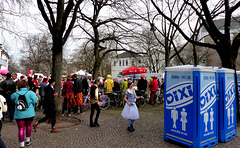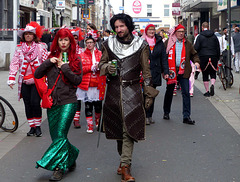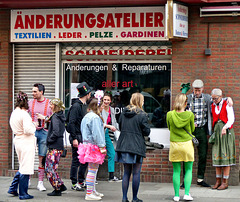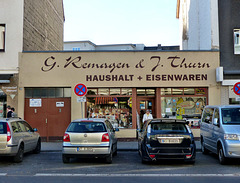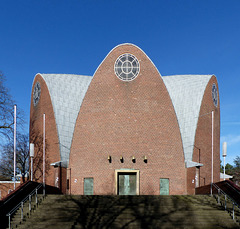Martin M. Miles' photos
Cologne - Herz Jesu
| |
|
|
Cologne is the fourth-largest city in Germany - and one of the oldest. A Germanic tribe, the Ubii, had a settlement here, this was named by the Romans "Oppidum Ubiorum". In 50 AD, the Romans founded "Colonia Claudia Ara Agrippinensium", the city then became the provincial capital of "Germania Inferior".
During WWII Cologne was bombed in 262 separate air raids. In April 1945, when the American armee reached Cologne, the city was completely ruined. About 90% of all houses in the inner city were - gone. In 1939 Cologne had had a population of more than 700.00. In spring 1945 there were only about 40.000, living in the ruins. So most of the buildings in Cologne are pretty "young".
The Herz-Jesu church, erected in the center of the "Zülpicher Platz" from 1893 on, got severely damaged during the air raids. So after WWII only the neo-Gothic tower and a part of the choir could got restored between 1953 and 1957. The nave, seen here, got rebuilt in a modern style.
Cologne - Herz Jesu
| |
|
|
Cologne is the fourth-largest city in Germany - and one of the oldest. A Germanic tribe, the Ubii, had a settlement here, this was named by the Romans "Oppidum Ubiorum". In 50 AD, the Romans founded "Colonia Claudia Ara Agrippinensium", the city then became the provincial capital of "Germania Inferior".
During WWII Cologne was bombed in 262 separate air raids. In April 1945, when the American armee reached Cologne, the city was completely ruined. About 90% of all houses in the inner city were - gone. In 1939 Cologne had had a population of more than 700.00. In spring 1945 there were only about 40.000, living in the ruins. So most of the buildings in Cologne are pretty "young".
The Herz-Jesu church, erected in the center of the "Zülpicher Platz" from 1893 on, got severely damaged during the air raids. So after WWII only the neo-Gothic tower and a part of the choir could got restored between 1953 and 1957. The nave got rebuilt in a modern style.
Cologne - Carnival
| |
|
Carnival has a long tradition not only in Cologne, where it is known and often got suppressed since medieval times. The French did not like it, but allowed carnival in 1804, from then on, carneval societies were founded often making fun of (French and later Prussian) militarism.
The "fifth season" (carnival season) is declared open at 11 minutes past 11 on the 11th of the 11th month November. That is the time of balls and sessions. The carneval hits the streets on Fat Thursday (Weiberfastnacht) with a declaration at the Alter Markt square at 11.11h. on the Thursday before the beginning of Lent.
Shops are closed, pubs are open, Cologne folks are masqueraded, bands perform on streets and squares, people sing and dance. For somebody not born here - it feels a bit strange.
Cologne - Carnival
| |
|
|
Carnival has a long tradition not only in Cologne, where it is known and often got suppressed since medieval times. The French did not like it, but allowed carnival in 1804, from then on, carneval societies were founded often making fun of (French and later Prussian) militarism.
The "fifth season" (carnival season) is declared open at 11 minutes past 11 on the 11th of the 11th month November. That is the time of balls and sessions. The carneval hits the streets on Fat Thursday (Weiberfastnacht) with a declaration at the Alter Markt square at 11.11h. on the Thursday before the beginning of Lent.
Shops are closed, pubs are open, Cologne folks are masqueraded, sing and dance. For somebody not born here - it feels a bit strange.
The emperor and his jester return from the bottle shop.
Cologne - Carnival
| |
|
Carnival has a long tradition not only in Cologne, where it is known and often got suppressed since medieval times. The French did not like it, but allowed carnival in 1804, from then on, carneval societies were founded often making fun of (French and later Prussian) militarism.
The "fifth season" (carnival season) is declared open at 11 minutes past 11 on the 11th of the 11th month November. That is the time of balls and sessions. The carneval hits the streets on Fat Thursday (Weiberfastnacht) with a declaration at the Alter Markt square at 11.11h. on the Thursday before the beginning of Lent.
Shops are closed, pubs are open, Cologne folks are masqueraded, sing and dance. For somebody not born here - it feels a bit strange.
Cologne - Carnival
| |
|
Carnival has a long tradition not only in Cologne, where it is known and often got suppressed since medieval times. The French did not like it, but allowed carnival in 1804, from then on, carneval societies were founded often making fun of (French and later Prussian) militarism.
The "fifth season" (carnival season) is declared open at 11 minutes past 11 on the 11th of the 11th month November. That is the time of balls and sessions. The carneval hits the streets on Fat Thursday (Weiberfastnacht) with a declaration at the Alter Markt square at 11.11h. on the Thursday before the beginning of Lent.
Shops are closed, pubs are open, Cologne folks are masqueraded, sing and dance. For somebody not born here - it feels a bit strange.
Folks are not only queueing to enter pubs. They as well stand in line for - toilets.
Cologne - Carnival
| |
|
Carnival has a long tradition not only in Cologne, where it is known and often got suppressed since medieval times. The French did not like it, but allowed carnival in 1804, from then on, carneval societies were founded often making fun of (French and later Prussian) militarism.
The "fifth season" (carnival season) is declared open at 11 minutes past 11 on the 11th of the 11th month November. That is the time of balls and sessions. The carneval hits the streets on Fat Thursday (Weiberfastnacht) with a declaration at the Alter Markt square at 11.11h. on the Thursday before the beginning of Lent.
Shops are closed, pubs are open, Cologne folks are masqueraded, sing and dance. For somebody not born here - it feels a bit strange.
Folks are queueing to enter "Früh im Veedel", a popular pub next to the Severinstor.
Cologne - Carnival
| |
|
Carnival has a long tradition not only in Cologne, where it is known and often got suppressed since medieval times. The French did not like it, but allowed carnival in 1804, from then on, carneval societies were founded often making fun of (French and later Prussian) militarism.
The "fifth season" (carnival season) is declared open at 11 minutes past 11 on the 11th of the 11th month November. That is the time of balls and sessions. The carneval hits the streets on Fat Thursday (Weiberfastnacht) with a declaration at the Alter Markt square at 11.11h. on the Thursday before the beginning of Lent.
Shops are closed, pubs are open, Cologne folks are masqueraded, sing and dance. For somebody not born here - it feels a bit strange.
Cologne - Carnival
| |
|
Carnival has a long tradition not only in Cologne, where it is known and often got suppressed since medieval times. The French did not like it, but allowed carnival in 1804, from then on, carneval societies were founded often making fun of (French and later Prussian) militarism.
The "fifth season" (carnival season) is declared open at 11 minutes past 11 on the 11th of the 11th month November. That is the time of balls and sessions. The carneval hits the streets on Fat Thursday (Weiberfastnacht) with a declaration at the Alter Markt square at 11.11h. on the Thursday before the beginning of Lent.
Shops are closed, pubs are open, Cologne folks are masqueraded, sing and dance. For somebody not born here - it feels a bit strange.
Folks are queueing to enter Filos, a pub in the Südstadt. Note the blue puppet. This is "Nubbel", a strawfilled puppet, that can be found over most pubs. Nubbel is a scapegoat. Nobbel will be blamed for all sins of anybody that may have happened over carnival. Nubbel will be sentenced to death and burned in the night before Ash Wednesday.
Cologne - Cathedral
| |
|
Cologne is the fourth-largest city in Germany - and one of the oldest. A Germanic tribe, the Ubii, had a settlement here, this was named by the Romans "Oppidum Ubiorum". In 50 AD, the Romans founded "Colonia Claudia Ara Agrippinensium", the city then became the provincial capital of "Germania Inferior".
A Roman temple existed here in Roman times, but from th3 4th century on, the site was occupied by Christian buildings.
The foundation stone of the Cologne Cathedral (Kölner Dom) was laid on 15 August 1248. The eastern arm was completed and got consecrated in 1322. In 1473 the works came to a halt, leaving the south tower complete up to the belfry level and crowned with a huge crane for the next 400 years.
After the original plans for the façade had been found in Darmstadt and Paris 1814/1816 it was decided to complete the cathedral. Two thirds of the costs were raised by civic efforts, while the remaining costs were covered by the Prussian state. The state saw this as a way to improve its relations with the large number of Catholic subjects it had gained in 1815, when the Catholic Rhineland was added to the Protestant Prussian Kingdom.
In 1842 Frederick William IV of Prussia and Johannes von Geissel, later archbishop of Cologne, laid the foundation stone for the completion. In 1880, 632 years after construction had begun, the Cologne Cathedral was completed. The celebration was attended by Emperor Wilhelm I.
The design of Cologne Cathedral was based quite closely on that of Amiens Cathedral. As it is a Gothic cathedral, the plan is in the shape of a Latin Cross with two aisles on either side. The window surface area is about 10.000m², About 1.500m² of these are medieval. The oldest is from 1260.
The "Richter-Fenster" named after the artist Gerhard Richter, who created it, is the youngest. In 1863 a window with the depiction of secular and Christian rulers had been installed here, donated by the Kingdom of Prussia. This windows was destroyed in World War II and got replaced by a colourless ornamental window in 1948, that soon needed restauration. In 2006 Gerhard Richter (* 1932) got comissioned by the chapter to created the window seen here.
On a surface of 106m² there are 11.263 glass squares in 72 colours. These square are randomly arranged. This window was very disputed! The archbishop, who is not a member of the chapter, did not like it at all. Most others did - and do. It creates a wonderful light.
A close up.
Cologne - Cathedral
| |
|
|
Cologne is the fourth-largest city in Germany - and one of the oldest. A Germanic tribe, the Ubii, had a settlement here, this was named by the Romans "Oppidum Ubiorum". In 50 AD, the Romans founded "Colonia Claudia Ara Agrippinensium", the city then became the provincial capital of "Germania Inferior".
A Roman temple existed here in Roman times, but from th3 4th century on, the site was occupied by Christian buildings.
The foundation stone of the Cologne Cathedral (Kölner Dom) was laid on 15 August 1248. The eastern arm was completed and got consecrated in 1322. In 1473 the works came to a halt, leaving the south tower complete up to the belfry level and crowned with a huge crane for the next 400 years.
After the original plans for the façade had been found in Darmstadt and Paris 1814/1816 it was decided to complete the cathedral. Two thirds of the costs were raised by civic efforts, while the remaining costs were covered by the Prussian state. The state saw this as a way to improve its relations with the large number of Catholic subjects it had gained in 1815, when the Catholic Rhineland was added to the Protestant Prussian Kingdom.
In 1842 Frederick William IV of Prussia and Johannes von Geissel, later archbishop of Cologne, laid the foundation stone for the completion. In 1880, 632 years after construction had begun, the Cologne Cathedral was completed. The celebration was attended by Emperor Wilhelm I.
The design of Cologne Cathedral was based quite closely on that of Amiens Cathedral. As it is a Gothic cathedral, the plan is in the shape of a Latin Cross with two aisles on either side. The window surface area is about 10.000m², About 1.500m² of these are medieval. The oldest is from 1260.
The "Richter-Fenster" named after the artist Gerhard Richter, who created it, is the youngest. In 1863 a window with the depiction of secular and Christian rulers had been installed here, donated by the Kingdom of Prussia. This windows was destroyed in World War II and got replaced by a colourless ornamental window in 1948, that soon needed restauration. In 2006 Gerhard Richter (* 1932) got comissioned by the chapter to created the window seen here.
On a surface of 106m² there are 11.263 glass squares in 72 colours. These square are randomly arranged. This window was very disputed! The archbishop, who is not a member of the chapter, did not like it at all. Most others did - and do. It creates a wonderful light.
Cologne - Remagen & Thurn
| |
|
Cologne is the fourth-largest city in Germany - and one of the oldest. A Germanic tribe, the Ubii, had a settlement here, this was named by the Romans "Oppidum Ubiorum". In 50 AD, the Romans founded "Colonia Claudia Ara Agrippinensium", the city then became the provincial capital of "Germania Inferior".
So far, I have nearly never noticed old hardware stores, but since I found Edward Bosen´s given up shop in Sülz, I see them everywhere. They all have their traditions. "G. Remagen & J. Thurn" is for sure the leading hardware shop in Rhiel. The gap between the two large houses, that now flank the shop, is probably the result of an air-raid damage.
Cologne - St. Engelbert
| |
|
|
Cologne is the fourth-largest city in Germany - and one of the oldest. A Germanic tribe, the Ubii, had a settlement here, this was named by the Romans "Oppidum Ubiorum". In 50 AD, the Romans founded "Colonia Claudia Ara Agrippinensium", the city then became the provincial capital of "Germania Inferior".
St. Engelbert is a circular church built on a pedestal. The tower is like a campanile separated from the building. The basic form of the church is formed by parabolic, high outer walls, which form a circular shape with segments curved like a shield.
The church, designed by architect Dominikus Böhm, was erected 1931 and got consecrated, though not finally completed, in 1932. This building was only possible using the modern material of reinforced concrete. The shape of the paraboloidal vaulting in a central point and the slender shape of the 40 meter high campanile required a concrete structure backed by reinforced concrete. The outside walls got clad with clinkers.
Unfortunately the church, sometimes dubbed "Zitronenpresse" (lemon squeezer), was locked. What was a real pity!
Cologne - St. Engelbert
| |
|
|
Cologne is the fourth-largest city in Germany - and one of the oldest. A Germanic tribe, the Ubii, had a settlement here, this was named by the Romans "Oppidum Ubiorum". In 50 AD, the Romans founded "Colonia Claudia Ara Agrippinensium", the city then became the provincial capital of "Germania Inferior".
St. Engelbert is a circular church built on a pedestal. The tower is like a campanile separated from the building. The basic form of the church is formed by parabolic, high outer walls, which form a circular shape with segments curved like a shield.
The church, designed by architect Dominikus Böhm, was erected 1931 and got consecrated, though not finally completed, in 1932. This building was only possible using the modern material of reinforced concrete. The shape of the paraboloidal vaulting in a central point and the slender shape of the 40 meter high campanile required a concrete structure backed by reinforced concrete. The outside walls got clad with clinkers.
Unfortunately the church, sometimes dubbed "Zitronenpresse" (lemon squeezer), was locked. What was a real pity!
Cologne - Zarathustra
| |
|
|
|
Cologne, the fourth-largest city in Germany, has all kinds and styles of restaurants and eateries.
Zarathustra is a persian restaurant in the quarter near the university, that serves some reasonably priced dishes over noontime.
Stewed lamb with eggplants, lentils, okra - and rice.
Cologne - Kunibertsturm
| |
|
|
|
Cologne is the fourth-largest city in Germany - and one of the oldest. A Germanic tribe, the Ubii, had a settlement here, this was named by the Romans "Oppidum Ubiorum". In 50 AD, the Romans founded "Colonia Claudia Ara Agrippinensium", the city then became the provincial capital of "Germania Inferior".
The Kunibertsturm is the last remaining part of a strongly fortified gate, erected in the 11th century. During the time of the Inquisition, the tower was used as a prison and people probably got tortured here by their prosecutors.
In Cologne this tower is known under the name "Weckschnapp", refering to a legend, which reports on a cruel form of execution. The guards should have hung a "Weck" (piece if bread) onto the high ceiling of the prison. Since the prisoners got no further food, they tried after some time to jump up to "schnapp" (snap) the bread. They then fell through an opening trap door through shaft, equipped with knives, that led directly into the Rhine river. The legend tells, that only one, extremely thin prisoner ever survived.
Cologne - Zoo
| |
|
|
Cologne is the fourth-largest city in Germany - and one of the oldest. A Germanic tribe, the Ubii, had a settlement here, this was named by the Romans "Oppidum Ubiorum". In 50 AD, the Romans founded "Colonia Claudia Ara Agrippinensium", the city then became the provincial capital of "Germania Inferior".
An "Actiengesellschaft Zoologischer Garten zu Cöln" was founded in 1858 and the zoo was started in 1860, after a large area north of the center was acquired. The zoo flourished end of the 19th century, but suffered severely under the two worldwars. At the end of WWII the zoo was almost completely destroyed. Only 23 animals had survived.
The zoo was reopened in 1947 and new animals could be purchased. One of them was in 1950 the chimpanzee "Petermann". The chimpanzee grew up without other chimpanzees. The monkey was finally trained to perform tricks and imitate human behavior and developed into a mascot for the Cologne zoo.
At the age of 10 Petermann got more and more aggressive. The "human" socialization to the exclusion of other monkeys led to serious behavioral problems. On October 10 1985, the cage door had not been properly locked and Petermann broke out of his cage. He attacked the zoo director Gunther Nogge, bit him into his head and face. Nogge was badly injured before workers were able to separate Petermann from the victim. Petermann continued his escape and was shot dead on the zoo grounds.
Seen here are Persian onagers. An endangered species of wild asses.
Cologne - Händelstrasse
| |
|
|
Cologne is the fourth-largest city in Germany - and one of the oldest. A Germanic tribe, the Ubii, had a settlement here, this was named by the Romans "Oppidum Ubiorum". In 50 AD, the Romans founded "Colonia Claudia Ara Agrippinensium", the city then became the provincial capital of "Germania Inferior".
During WWII Cologne was bombed in 262 separate air raids. In April 1945, when the American armee reached Cologne, the city was completely ruined. About 90% of all houses in the inner city were - gone. In 1939 Cologne had had a population of more than 700.00. In spring 1945 there were only about 40.000, living in the ruins. So most of the buildings in Cologne are pretty "young".
This Jugendstil-building is well restored. Two fighting cocks over the doors. The architect´s signature "F. Dahmen" can still be seen. Dahmen was prize winning architect in Cologne in the early 20th century.
Jump to top
- ipernity © 2007-2024
- Help & Contact
|
Club news
|
About ipernity
|
History |
ipernity Club & Prices |
Guide of good conduct
Donate | Group guidelines | Privacy policy | Terms of use | Statutes | In memoria -
Facebook
Twitter



